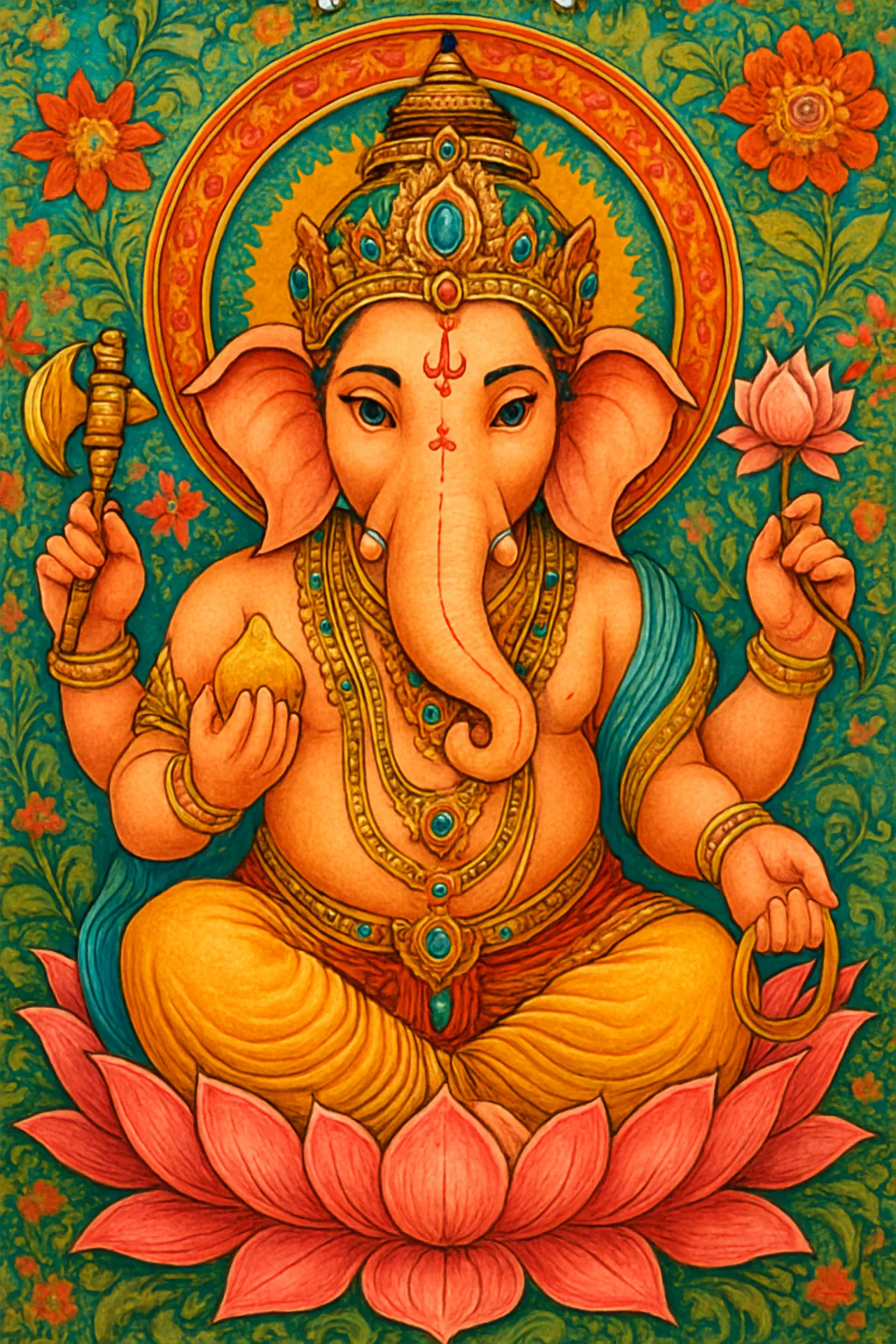Sri Ganesh Chaturthi: The Festival of Wisdom and Prosperity

Introduction
India is a land of festivals, each carrying deep spiritual, cultural, and social significance. Among these, Sri Ganesh Chaturthi holds a very special place in the hearts of millions of devotees. Celebrated with grandeur across India and among Hindu communities worldwide, the festival marks the birth anniversary of Lord Ganesha, the revered deity known as the remover of obstacles, patron of arts and sciences, and harbinger of good fortune.
The festival is not only a religious event but also a cultural extravaganza that unites people across states, communities, and traditions.
Significance of Lord Ganesha
Lord Ganesha, also called Vighnaharta (remover of obstacles) and Siddhivinayaka (bestower of success), is one of the most worshiped deities in Hinduism. The son of Lord Shiva and Goddess Parvati, he is easily recognized by his elephant head, pot-belly, and his association with wisdom, learning, and auspicious beginnings.
According to Hindu beliefs, Lord Ganesha is worshiped at the start of any endeavor—be it an exam, a wedding, a business venture, or even a new construction. The symbolism of Ganesha is equally profound:
- His large head signifies wisdom and knowledge.
- His small eyes denote concentration.
- His large ears teach us to listen more.
- His trunk represents adaptability and efficiency.
- The mouse, his vehicle, symbolizes humility—reminding us that even the smallest creature can carry the mightiest.
This deep symbolic connection explains why the festival of his birth is celebrated with such devotion and joy.
Historical Background and Origin
The roots of Ganesh Chaturthi can be traced to the Puranas, where the story of Ganesha’s birth is narrated. The most popular legend says that Goddess Parvati created Ganesha from turmeric paste and gave him life to guard her chamber. When Lord Shiva tried to enter, Ganesha, not recognizing him, stopped him. In anger, Shiva severed his head, but upon realizing the truth, replaced it with that of an elephant, granting Ganesha a new life and divine powers.
The festival first gained public prominence during the Maratha rule under Chhatrapati Shivaji in the 17th century. It was celebrated as a state festival to promote culture and unity. However, it was during the late 19th century, under the leadership of Lokmanya Bal Gangadhar Tilak, that Ganesh Chaturthi was transformed into a mass public celebration. Tilak initiated large public processions and gatherings for the festival, using it as a platform to bring people together and inspire patriotism against British colonial rule. Since then, Ganesh Chaturthi has been celebrated widely with both devotional fervor and cultural pride.
Rituals and Celebrations
Ganesh Chaturthi is a ten-day festival, beginning on the Shukla Chaturthi (the fourth day of the waxing moon) of the Hindu month of Bhadrapada (August–September). The festival culminates with Ganesh Visarjan on Ananta Chaturdashi (the fourteenth day).
Preparation and Installation of Idols
Weeks before the festival, artisans craft beautiful idols of Lord Ganesha, ranging from small eco-friendly clay idols to elaborate large ones placed in public pandals (temporary structures). On the day of the festival, devotees perform prana pratistha (ritual of invoking life into the idol) followed by puja and offerings of flowers, durva grass, red hibiscus, fruits, coconut, and the famous sweet modak, which is considered Ganesha’s favorite.
Daily Prayers and Offerings
During the ten days, families and communities worship Ganesha with aarti (devotional songs), bhajans, chanting of mantras, and distribution of prasadam. Cultural activities such as dance, drama, singing, debates, and social gatherings are also organized in public pandals, uniting people beyond religious boundaries.
Ganesh Visarjan
The festival concludes with the immersion, or visarjan, of the Ganesh idol in water—rivers, lakes, or the sea. The immersion process is accompanied by grand processions, music, and chants of “Ganapati Bappa Morya, Pudhchya Varshi Lavkar Ya” (O Lord Ganesha, come again soon next year!). The immersion signifies the cycle of creation and dissolution in nature and the belief that Ganesha returns to Mount Kailash to his parents until next year.
Regional Variations
Though Ganesh Chaturthi is celebrated throughout India, the customs differ slightly from region to region:
- Maharashtra: The state most famous for its grand processions and spectacular pandals. Cities like Mumbai and Pune see towering idols and millions of people joining in the festivities.
- Goa: Here the festival is known as Chavath and emphasizes family rituals with clay idols worshipped at home.
- Karnataka: The celebrations in Bengaluru and rural towns often merge with local folk culture, emphasizing community plays and dances.
- Andhra and Telangana: Families prepare special sweets like laddu and offer prayers at home. Many temples organize cultural programs.
- Tamil Nadu and Kerala: Known as Vinayaka Chaturthi, it is marked by devotional songs, abanctions, and emphasis on eco-friendly clay idols.
- Outside India: Ganesh Chaturthi is celebrated by Indian communities in places like Mauritius, Fiji, Nepal, Singapore, the UK, the US, and Canada, showing its global cultural significance.
Spiritual Message and Cultural Importance
Beyond devotion, the festival carries deep spiritual and cultural messages.
- Unity in Diversity: The celebration brings people from different castes, religions, and economic backgrounds together.
- Environmental Awareness: In recent years, there has been a growing emphasis on eco-friendly idols made of clay or natural materials instead of those containing harmful chemicals. This movement reflects the awareness of balancing devotion with responsibility toward nature.
- Moral Teachings: Ganesha symbolizes wisdom, patience, humility, and respect—virtues much needed in modern times.
- Social Bonding: Public gatherings foster social interaction, collective decision-making, and group harmony.
Contemporary Relevance
Today, Sri Ganesh Chaturthi is not just a religious festival but also a cultural movement. Large pandals attract thousands, showcasing artistic creativity, themes related to social messages, environmental concerns, and even national pride. Modern celebrations often highlight global issues such as climate change, education for all, and girl child empowerment.
The festival also boosts the economy. Artisans, idol makers, decorators, flower sellers, and sweet vendors all benefit from the festivities. In cities like Mumbai, the tourism and cultural economy thrives during this period.
Challenges and Changes
While the festival is joyous, it comes with challenges:
- Environmental Pollution: Non-biodegradable idols cause water pollution during immersion. Efforts toward eco-friendly idols and artificial immersion tanks are gaining momentum.
- Over-commercialization: Sometimes devotion takes a backseat to extravagance and competition in creating the biggest or grandest pandal.
- Traffic and Noise Pollution: The large processions, though celebratory, can cause inconvenience. Municipal bodies now regulate timings, sound levels, and traffic management.
Despite challenges, the spirit of devotion and community togetherness keeps the festival vibrant and relevant year after year.
Conclusion
Sri Ganesh Chaturthi is one of the most significant festivals in Hindu culture, combining deep spirituality, rich traditions, and community unity. It reminds us of the timeless values represented by Lord Ganesha—wisdom, patience, humility, and the removal of obstacles. More importantly, it strengthens social bonds, nurtures artistic talents, and promotes environmental consciousness in modern times.
The festival is not merely about worshiping a deity but about celebrating life itself in all its forms—with joy, unity, and devotion. As chants of Ganapati Bappa Morya fill the air each year, it symbolizes the eternal hope of humanity: overcoming obstacles, achieving success, and living in harmony with nature.




